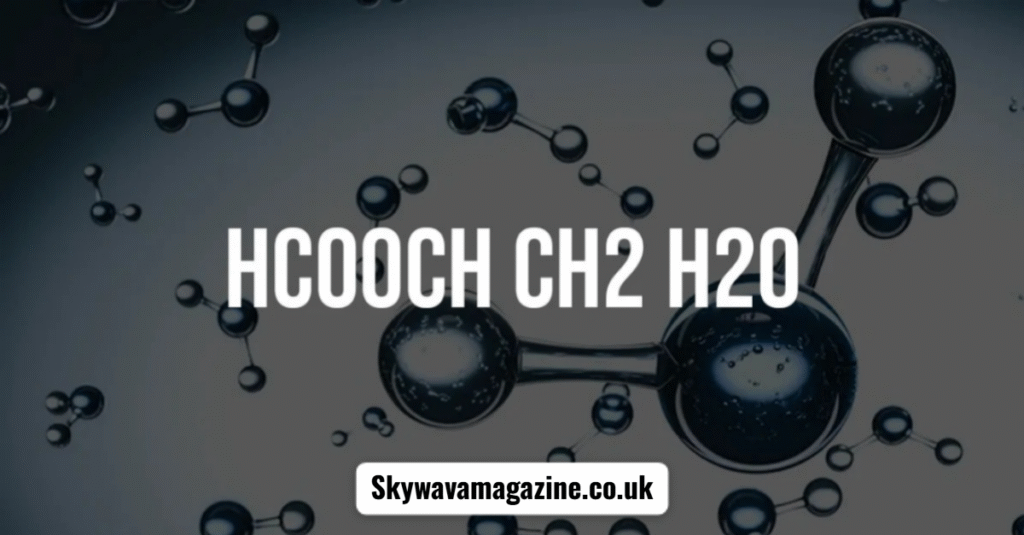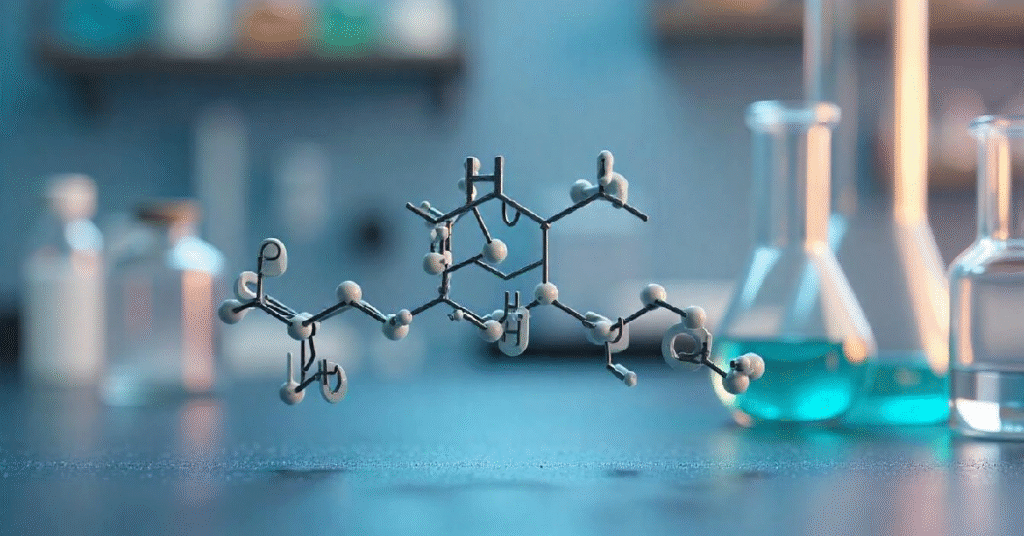
“hcooch ch2 h2o” refers not to a single, recognized molecule but to a system combining methyl formate (HCOOCH₃), a methylene (CH₂) component, and water (H₂O). The key reaction is the hydrolysis of methyl formate with water to yield formic acid and methanol under acidic or basic catalysis.
This overview clarifies that hcooch ch2 h2o is essentially shorthand for the chemical interplay among methyl formate, CH₂‐type intermediates or groups, and water. In this system, the hydrolysis of methyl formate using H₂O (water) is central. Conditions like temperature, pH, catalysts strongly affect yield of formic acid (HCOOH) and methanol (CH₃OH). Applications spread across green chemistry, industrial solvents, and energy research. Misconceptions are common: many assume hcooch ch2 h2o is one molecule, when in fact it’s a reactive framework describing how the components relate in reaction and context.
Introduction: Why This Chemical Equation Matters
Chemistry often intimidates people with its complex symbols and dense equations, but behind every formula lies a fascinating story of interaction, transformation, and purpose. One such lesser-known yet highly intriguing chemical formula is “HCOOCH CH2 H2O.” At first glance, it may appear cryptic, but it reveals a compelling reaction involving organic chemistry, esters, and hydrolysis. This formula, while not common in casual conversations, is extremely valuable for students, researchers, and professionals involved in organic synthesis and industrial chemistry.
In this detailed guide, we’ll dissect and decode the true significance of “HCOOCH CH2 H2O,” exploring its chemical structure, behavior in reactions, industrial relevance, and much more. By the end, you’ll not only understand this chemical setup but also see how it fits into the broader world of chemical science.
Let’s begin this journey into molecular behavior and transformation.
HCOOCH: What Is It Really?

HCOOCH, also known as methyl formate, is an organic ester formed from formic acid (HCOOH) and methanol (CH3OH). The structure can be visualized as:
- Formate group (HCOO–)
- Methyl group (–CH3)
Methyl formate (HCOOCH3) is a colorless, highly flammable liquid with a characteristic odor, often used as a solvent in industrial applications. It is one of the simplest esters and holds significant importance in organic chemistry due to its reactivity and versatility.
Now, let’s understand how this molecule reacts in the presence of other agents like CH2 (methylene) and H2O (water) in broader chemical processes.
The Role of CH2: The Carbon Link in the Chain
In the context of organic chemistry, CH2 represents the methylene group. It’s a divalent functional group with two valence electrons available for bonding. While the standalone CH2 unit is highly reactive and doesn’t typically exist freely, it plays a crucial intermediary role in many organic transformations.
In this reaction’s context, CH2 is likely acting as a linking bridge, connecting or modifying molecules in the presence of esters like HCOOCH and reactants like water (H2O). This brings us to the next vital aspect: hydrolysis.
H2O: Catalyst and Reactant in Hydrolysis
Water (H2O) plays a transformative role in many organic reactions, especially in hydrolysis. In ester hydrolysis, water breaks down esters like HCOOCH3 into their original alcohol and acid:
- Ester + Water → Alcohol + Acid
- HCOOCH3 + H2O → HCOOH + CH3OH
This process is either acid-catalyzed or base-catalyzed, depending on the reaction conditions. The addition of water disrupts the ester bond, resulting in separate components that can be used in other reactions or for industrial production.
Combining HCOOCH, CH2, and H2O: Understanding the Overall Reaction
While HCOOCH CH2 H2O doesn’t describe a conventional or standalone formula, it points toward a reaction involving:
- Methyl formate (HCOOCH3)
- A CH2 linking structure (possibly part of a polymer or intermediate molecule)
- Water (H2O)
Together, they suggest a hydrolysis or substitution process in an organic system. This might take place in:
- Polymer degradation
- Solvent reaction chains
- Ester cleavage reactions
- Formylation of organic compounds
This combination emphasizes the essential interplay between ester structure, reactive carbon intermediates, and water-based reactions.
Real-Life Application of This Chemistry
This reaction isn’t just academic; it holds real-world value in several industries. Here’s how this chemistry contributes in practical terms:
- Used in manufacturing formic acid and methanol in controlled lab environments.
- Plays a role in producing solvents and fuels, especially in green chemistry.
- Forms the foundation for organic synthesis in pharmaceutical development.
- Vital in fragrance and flavor synthesis due to ester reactivity.
- Applied in polymer science for modifying organic backbones.
Let’s look at this in a comparative table.
HCOOCH Reactivity with Water: Acidic or Basic Conditions?
The hydrolysis of methyl formate (HCOOCH3) can proceed under either acidic or basic conditions. In acidic hydrolysis:
- The reaction is reversible.
- Catalyzed by HCl or H2SO4.
- Useful in fine-tuned laboratory synthesis.
In basic hydrolysis (also known as saponification):
- The reaction is irreversible.
- A base like NaOH is used.
- Leads to stable salt and alcohol formation.
Here’s a simplified equation:
- HCOOCH3 + H2O → HCOOH + CH3OH (acidic condition)
- HCOOCH3 + NaOH → HCOONa + CH3OH (basic condition)
Understanding these reaction conditions is key in controlling the yield and purity of final products.
The Organic Chemistry Behind CH2 Groups
The methylene group (CH2) is not inert; it often participates in:
- Chain propagation in polymers
- Intermediate formation in aldol reactions
- Free radical substitution processes
In advanced organic synthesis, CH2 units help extend carbon chains or react with electrophilic or nucleophilic species. They are essential in fine-tuning the length and behavior of organic molecules. In our scenario, they possibly modify or connect esters in a complex reaction environment.
Also Read this: Love2Love.lv: Your Gateway to Intimacy and Connection
Why Ester Hydrolysis Matters in Industry
Esters like HCOOCH3 are widely used due to their fruity smell and reactive properties. But sometimes, we need to break them down:
- To purify or isolate acids or alcohols
- To prepare raw materials for drug synthesis
- To ensure environmental degradation in green solvents
In all these cases, water (H2O) becomes an eco-friendly, low-cost, and non-toxic reagent for efficient transformation.
Challenges in Handling HCOOCH Reactions

While methyl formate is useful, it presents challenges too:
- Highly flammable and volatile
- Can cause irritation upon inhalation
- Requires careful pH and temperature control in reactions
- Unstable in open-air environments due to moisture
Laboratories and industries must follow strict safety and storage protocols when dealing with such esters.
Real-World Example: Production of Formic Acid
One prominent application of HCOOCH3 + H2O hydrolysis is the industrial production of formic acid (HCOOH):
- Large-scale use in leather tanning, silage preservation, and rubber manufacturing.
- Eco-friendly alternative to sulfuric acid in some applications.
- Lower toxicity profile compared to other industrial acids.
Using water-based hydrolysis helps minimize environmental damage and maximize yield purity.
Environmental Impact: Green Chemistry Aspects
Reactions involving esters, methylene units, and water often form the backbone of green chemistry strategies. Here’s why:
- Water is a sustainable, abundant reagent.
- Methyl formate is biodegradable.
- Controlled ester hydrolysis minimizes waste.
- Lower energy requirements for reactions.
This makes “HCOOCH CH2 H2O” not just a reaction, but a potential template for eco-responsible synthesis.
Is This Reaction Found in Nature?
Interestingly, methyl formate is also found in nature. It’s present in:
- Ripe fruits (giving sweet aroma)
- Ant venom (as a defense mechanism)
- Space clouds (detected in star-forming regions)
While CH2 and H2O are ubiquitous in biological systems, the full “HCOOCH CH2 H2O” reaction as described is primarily synthetic and controlled in labs.
Key Takeaways
- HCOOCH is methyl formate, a simple organic ester.
- CH2 acts as a reactive linker in organic reactions.
- H2O enables ester hydrolysis into alcohol and acid.
- This trio supports eco-friendly synthesis and fuel alternatives.
- Applications span pharmaceuticals, solvents, polymers, and green chemistry.
Table Recap: Functional Behavior Overview
| Component | Role in Reaction | Key Feature |
| HCOOCH3 | Ester undergoing hydrolysis | Forms formic acid and methanol |
| CH2 | Reactive methylene group | Bonds with other carbon structures |
| H2O | Hydrolyzing agent | Breaks ester bond in organic pathways |
Conclusion: Why “HCOOCH CH2 H2O” Matters in Chemistry
The chemical sequence denoted by “HCOOCH CH2 H2O” encapsulates a fundamental and versatile principle of organic chemistry—controlled molecular transformation using simple, accessible agents. From breaking ester bonds to generating key acids and alcohols, this reaction showcases the elegance of organic reactions and the potential of sustainable chemistry.
Whether you are a student diving into reaction mechanisms, a researcher designing synthetic routes, or an industry professional seeking efficient pathways, understanding this trifecta—methyl formate, methylene groups, and water—can unlock novel ideas and greener solutions in your field.
FAQs
What exactly does hcooch ch2 h2o represent?
Answer:
hcooch ch2 h2o is shorthand, not a valid IUPAC formula. It typically refers to methyl formate (HCOOCH₃), CH₂ groups or intermediates, and water (H₂O) as part of a reaction framework.
Is hcooch ch2 h2o a stable molecule?
Answer:
No. It’s not a single stable molecule. Instead, it describes how methyl formate reacts with water, with CH₂ appearing in reaction pathways or intermediates.
What happens when hcooch ch2 h2o undergoes hydrolysis?
Answer:
Hydrolysis of methyl formate with water produces formic acid (HCOOH) and methanol (CH₃OH). This is the main reaction implied by hcooch ch2 h2o.
What is the role of CH₂ in hcooch ch2 h2o?
Answer:
CH₂ is not stable alone but appears in fragments or transition states. In the context of hcooch ch2 h2o, it represents the methylene unit inside organic intermediates.
Why is hcooch ch2 h2o commonly misunderstood?
Answer:
Because the notation looks like a single chemical formula, many assume it’s one compound. In reality, it combines components (methyl formate, CH₂, and water) in shorthand form.
What are the products formed from the reaction of methyl formate with water?
Answer:
The hydrolysis yields formic acid and methanol, both widely used in industry. These are the key products when interpreting the hcooch ch2 h2o shorthand.
Where is this reaction useful in industry?
Answer:
Hydrolysis of methyl formate is used to produce formic acid (for leather, textiles, preservatives) and methanol (for fuels, solvents, and chemical synthesis).
Are there safety concerns with hcooch ch2 h2o chemistry?
Answer:
Yes. Methyl formate is flammable, methanol is toxic, and formic acid is corrosive. Any process involving hcooch ch2 h2o requires careful handling, protective gear, and good ventilation.
How does catalysis affect the reaction of hcooch ch2 h2o?
Answer:
Acid or base catalysts speed up hydrolysis. Without catalysts, the reaction is slow, but under optimized conditions, yields of formic acid and methanol increase significantly.
Is hcooch ch2 h2o relevant for green chemistry?
Answer:
Yes. By using water as a reactant and producing relatively simple products, the hcooch ch2 h2o system supports sustainable approaches in solvent development, renewable fuels, and eco-friendly synthesis.
Also Read This: Today S72E279: A Morning Show Masterpiece





